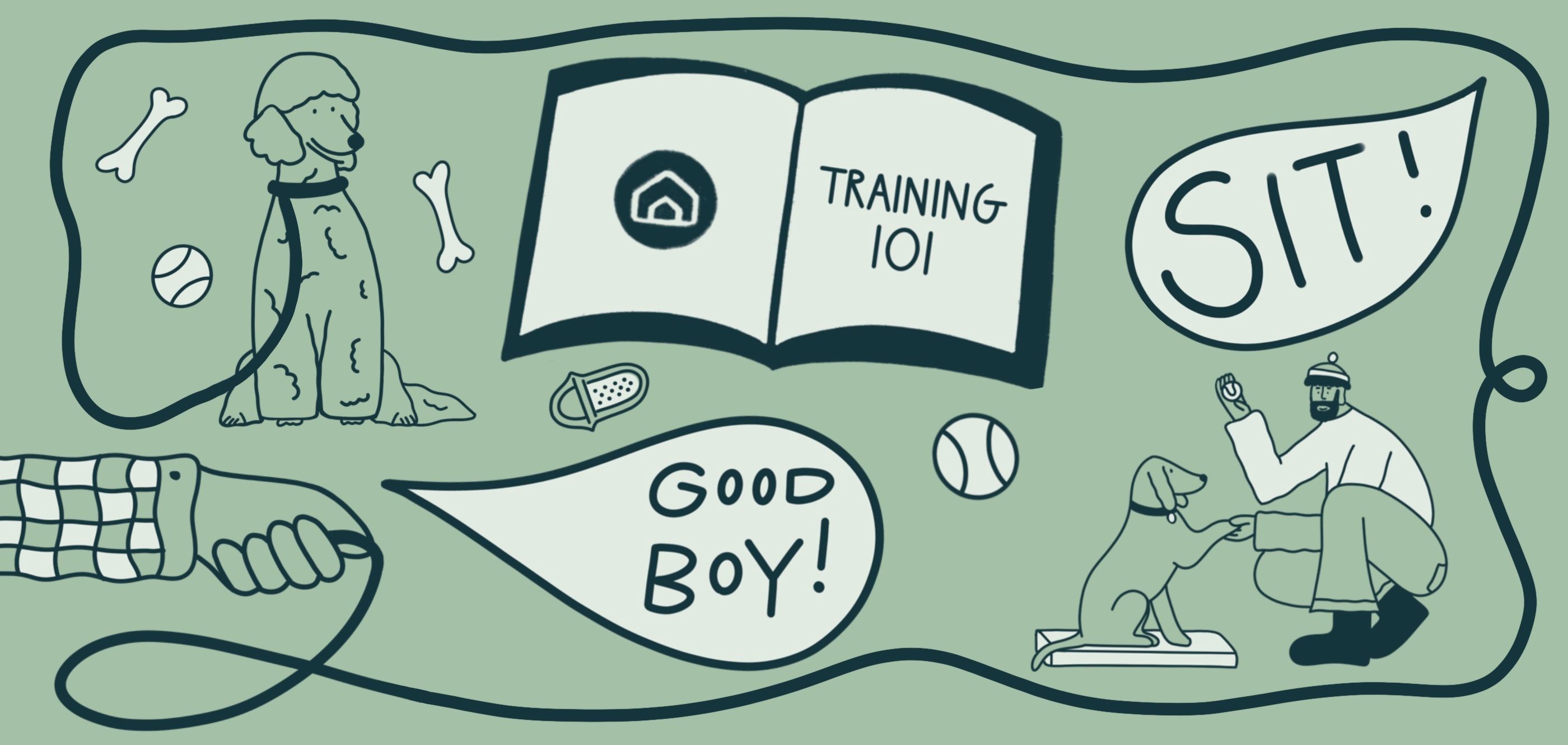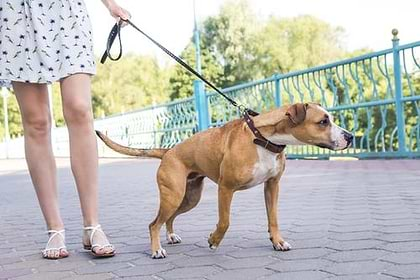
Have you got the puppy training blues? We’ve been there, too– it can be a difficult, patience-testing process. However, it’s all worth it to spend some time with your favorite little fluff ball and to know that she is growing up to be a smart, well-mannered dog!
To help, we’ve gathered up some of our top tips and important insights into different aspects of the training process, including puppy biting, leash manners, socialization, potty training, separation anxiety, and crate training. Follow these steps, and you’ll have an A+ puppy training student in no time!
How To Manage Puppy Biting
Sometimes, it seems like puppies look at their humans like one big chew toy! A little nibbling is totally normal and even expected. But, it’s important to tackle biting early and redirect these behaviors before those puppy bites can become stronger. Training your puppy to be gentle can be hard work, but it will pay off in the long run! These strategies can help:
1. Redirect your puppy:
- When your puppy is getting nippy with you, redirect their attention to something more appropriate. Using different textures works well to redirect your pup’s attention. Soft toys, chew sticks, raw veggies, and frozen treats are extremely helpful when it comes to soothing their gums!
- Redirect using items that have a similar texture to what your pup is chewing on.
- This also helps teach them that toys are for chewing, not fingers!
2. Don’t give in to the bites:
- If they bite you, turn your back on them and simply give a monotone “no”.
- Some puppies will respond better to being ignored, some will respond better to a sharp high-pitched “ow” and a pause in playtime.
- Think of it as if they were playing with a littermate and got too rough. The other pup would likely yelp, and that is an indicator it’s time to stop.
3. Don’t pull, go limp:
- This tip may not be easy to learn as it’s the opposite of what you want to do when you feel pain, but pulling away can get a puppy more excited.
- You want them to understand they hurt you and that upset you, even if it makes you feel a little guilty.
4. Teach your pup “gentle”:
- The gentle command is essentially switching from biting to licking.
- Close your fist around a treat and let your pup bite it. It’ll hurt, but eventually they’ll (hopefully) get a bit frustrated and either give up and back off or switch to licking. As soon as they do, use your clicker/clicker word and open your hand to give them the treat.
- If you’re able to teach your pup the gentle command, you can use it during playtime whenever they get too mouthy.
Working On Leash Manners With Your Dog
Does it ever feel like your dog is the one walking you? Once you and your pup spend time working on leash manners, walks will be stress-free– and your arm won’t be quite so sore! Here are some tips to help you get started:
1. Learn good (human) leash skills:
- Proper leash etiquette is important to help communicate cues to your dog, but also to keep you safe. Prevent sprained hands or wrists by holding the leash properly– slip the handle over your wrist or thumb and gather the excess in your hand.
- Remember: never wrap the leash around your hand!
- Don’t pull on the leash either or continually hold it tight. This can accidentally teach your puppy that they should “feel” the leash and can encourage pulling. Work on maintaining slack.
2. Ease into it:
- Start off by allowing your pup to get used to wearing a collar/harness. Develop some positive associations with both items in your home, before stepping outside. As with every aspect of training, be sure to reward your pup in this stage.
- Your instinct may be to start walking and working on leash training outside. But, the outside world is distracting and at times overwhelming. Take a step back and make sure your pup is comfortable walking in their safe zone first: inside the home!
3. Distract from leash biting:
- So many puppies love biting on their leash because they think it’s a toy. If you catch your pup doing that, be sure to distract them with a high-value treat. Hold the treat in front of your pup, and get their attention on the treat instead of pulling the leash out of their mouth. You can also give your pup something to carry in their mouth instead like a ball or stuffed toy.
4. Follow the leader:
- Encourage your pup to walk towards you. Walk around in small increments and reward your pup when they get to you. Continue to do so until your pup comes to you, and walks with you a few paces. Keep rewarding your dog at your side as you walk together.
- Remember: puppies have a short attention span! Keep your training and walking sessions short and sweet.
5. Say hello to the outside world:
- When you and your pup are ready, step outside! Don’t be discouraged if your pup is extremely distracted. Remember that this is all NEW to them, all the sounds, smells, and sights. Be patient and keep the walks short. If your pup seems extremely distracted, work on “follow the leader” outside. Reward your pup for following you, and try walking again.
Puppy Socialization During COVID-19
During the pandemic, social distancing has made it tough for all of us to socialize– puppies included! Don’t forget that socialization is about more than just making friends. It’s also important to expose your dog to new situations and experiences so that they will be ready to take on a post-pandemic world! Especially if you adopted your dog during COVID-19 and they haven't been able to meet other dogs yet, these ideas can help you socialize your dog in different ways:
1. Embrace new experiences:
- New experiences can range from opening an umbrella, ringing the doorbell, vacuuming the house, or putting on a hat/beanie! Be sure to praise and reward your pup throughout everything and allow them to go at their own pace.
- Exposure to different surfaces is also important. Grass, concrete, and carpet are all new feelings for a puppy, and they need to get comfortable with walking on different feeling surfaces.
2. Exposure to handling:
- Desensitize your pup when it comes to handling them. Touch their paws, tail, mouth, ears, chin, etc. Offer praise or a treat after each touch to help them learn to enjoy it.
- Buying a dog brush and nail clipper/grinder and grooming your pup at home is also an amazing way to desensitize them and provide positive exposure to getting groomed. That way, when your pup does eventually go to a groomer IRL, they will know what to expect.
3. Safe Play Dates & Walks:
- Exposure to new dogs and people is important for a well-socialized pup. All evidence from medical professionals indicated COVID can’t transfer from dogs to people, but social distancing and mask wearing should still be observed by all humans present!
- Puppy playtime at a local training facility is a great (and safe) option for this! Trainer supervised playtime in small groups ensures your puppy learns how to socialize with others. Just be sure to check the facilities procedures beforehand - many require appointments and have special protocols in place for COVID.
4. Establish your routine:
- Working from home means more time to spend with your pup, and less strict schedules. However, puppies thrive on schedules. So, try to make sure they eat, play, and nap at the same time every day. Pick a schedule that will match your “normal” post-pandemic life, not the one you have right now.
- Learning to be without people is as important as learning to be with them. All puppies need to be taught how to pass the time alone. Although it may be hard, it is crucial to teach your puppy to stay by themselves in a safe space like the crate or a gated area.
Mastering Puppy Potty Training
It’s inevitable– accidents happen! But, with a little patience (and these helpful hints), the potty training process can go smoothly:
1. Create a routine:
- Puppies THRIVE off of routine! Be sure to have a set schedule for your pup and follow it as best you can.
- Setting a routine means setting times for naps, play, and food.
- A routine will also help you better understand when your pup needs to be let out to potty.
2. Be consistent and patient:
- The general rule is that your pup can hold their bladder for the number of months they are plus one hour. For example, a 2-month-old puppy can hold their bladder for 3 hours maximum. To be safe, we would recommend taking your puppy out every hour or two until they are around 4 to 5 months old.
- Some puppies take days to potty train, others can take weeks. Patience and consistency will get you through!
3. Slow access:
- While house training, limit the amount of space your puppy has access to. This can be accomplished with baby gates, playpens, or crates.
- Crates, in particular, are an amazing potty training tool if used properly. It all relies on paying attention to your pup’s cues.
- Puppies don’t like to soil where they sleep. Reward your pup for going potty outside and crate them inside when you can’t supervise them to help them learn that they should always do their business outside.
4. Always praise, never scold:
- Scolding your pup after an accident is ineffective and can harm your pup’s relationship with you. Instead, praise them when they go outside– clap, cheer, give treats, pet them, go crazy!
- If they do have an accident, simply clean it up and move on. Make sure to use a cleaner that will kill odors so that your dog is not encouraged to go in that same spot next time.
- If you do happen to catch them starting to go to the bathroom, pick them up and immediately get them outside. Once outdoors, praise them!
Preventing Separation Anxiety In Dogs
Our dogs mean the world to us and it’s so hard to spend time apart. We may want to spend every minute snuggling and playing, but it is important to teach your dog that it’s totally okay to have some alone time, too. That way, when you do have to leave the house, your independent pal can rest easy knowing you’ll be back soon. These are some ways to help prevent separation anxiety:
1. Take baby steps:
- Work on desensitizing them to activities that could indicate you’re leaving, such as grabbing your keys, or putting on a jacket. Then, sit on the couch or go into another room. This helps teach your dog that the jingle of a key isn’t something to panic about.
- Once they’re calm with you prepping for going out, take it one step further by actually stepping outside. But again, baby steps! Start off by simply stepping outside for a few seconds, coming back in, and rewarding them with a treat.
2. Have a routine:
- Like a lot of us, puppies thrive off of routine. Although many of us are spending lots of time home right now, it's crucial to have a routine in place.
- Be sure to incorporate some “alone time” into your daily schedule. Whether that be dedicated time in the crate or a playpen, be sure to give your pup some time alone, away from you. Provide them with something fun to occupy their time like a food-stuffed chew toy.
3. Get some energy out beforehand:
- Before leaving your pup home alone, be sure that they have had the proper amount of exercise for the day. Remember: a tired pup is a happy pup!
- Take them for a long walk, or go for a trip to the park before leaving them alone. This will increase the chance of them sleeping through the time they’re alone, and decrease any destruction that may happen from boredom.
4. Calm greetings:
- We know you’ll miss your pup when you’re gone, but making a big deal of leaving can heighten stress for them. A simple pat and goodbye is better for your pup, even though it may be harder for you!
- The same rules apply when you get home. For your pup, you’re home and that’s that, nothing to get excited about. If your pup is jumping or is overly excited on your return, ask them to sit or lie down or ignore them until they are calm, then reward them with attention or treats when they are settled.
Crate Training Your Dog
Your dog’s crate is their very own corner of your home. Just like humans decorate and design their rooms to be comfortable, it’s important to make the crate a place that your pup wants to hang out and feels safe in. There are tons of benefits to crate training for both you and your dog! Here are some ways to start:
1. Make it a safe space:
- Be sure that your pup has positive associations with their crate. It is crucial for them to know that this is their safe space, not a place for punishment. To ensure that your pup feels this way, short training sessions are key, rather than diving right into long periods of time in their crate with no build-up.
- Consider feeding your pup their meals in the crate and be sure to reward them with a yummy treat when they do walk into their crate on their own!
2. Get creative!
- Crate games during the daytime are an awesome way to create that positive association with the crate. For example, play fetch by throwing your pup’s favorite toy into the crate and encouraging them to retrieve it.
- You can also use crate training tools, like our Groov, to build upon that positive association. Make the yummiest Groov treat for your pup and let them enjoy the deliciousness inside their crate!
3. Make it comfy and cozy:
- Cozy up the crate with a blanket or mat! It helps if you put in a blanket with the scent of their littermates, or a shirt that you always wear. These familiar scents may help soothe your puppy at night.
- Use a white noise machine to lull your pup to sleep. Puppies benefit from the same calming noises that humans do!
4. Location, location, location:
- Where you put the crate matters. Make sure to put the crate in a frequently occupied part of your house, such as your living room, rather than having it be in isolation.
- Having the crate in a shared living space also increases your pup’s exposure to the crate throughout the day!
The training process is such a special time of learning and growth for both you and your pup. We hope these tips are helpful as you and your new BFF start on the training journey!
Are there other training topics you want us to cover in a future post? Do you have any tips of your own to share? We would love to hear them! Feel free to reach out to our team.

The Diggs Team
We believe our dogs deserve safer, better designed pet products.
You might also like
Crate training tips, stories and inspiration
View all blogsIn Your Diggs
Share your photos with #DiggsPet and tag us @DiggsPet on IG and TikTok.


